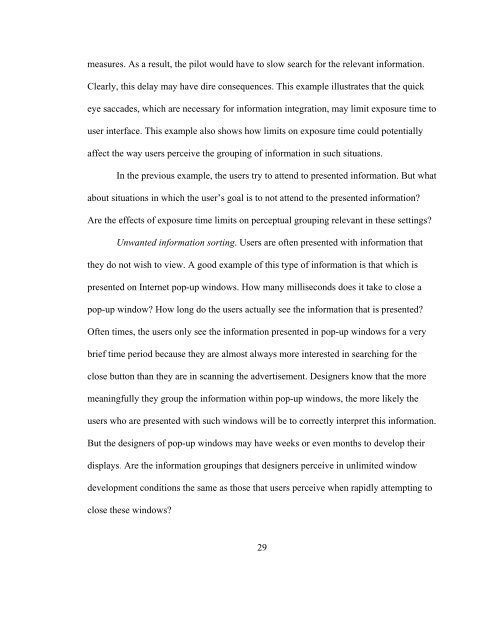The Use of Iambic Pentameter in the
The Use of Iambic Pentameter in the
The Use of Iambic Pentameter in the
Create successful ePaper yourself
Turn your PDF publications into a flip-book with our unique Google optimized e-Paper software.
measures. As a result, <strong>the</strong> pilot would have to slow search for <strong>the</strong> relevant <strong>in</strong>formation.<br />
Clearly, this delay may have dire consequences. This example illustrates that <strong>the</strong> quick<br />
eye saccades, which are necessary for <strong>in</strong>formation <strong>in</strong>tegration, may limit exposure time to<br />
user <strong>in</strong>terface. This example also shows how limits on exposure time could potentially<br />
affect <strong>the</strong> way users perceive <strong>the</strong> group<strong>in</strong>g <strong>of</strong> <strong>in</strong>formation <strong>in</strong> such situations.<br />
In <strong>the</strong> previous example, <strong>the</strong> users try to attend to presented <strong>in</strong>formation. But what<br />
about situations <strong>in</strong> which <strong>the</strong> user’s goal is to not attend to <strong>the</strong> presented <strong>in</strong>formation?<br />
Are <strong>the</strong> effects <strong>of</strong> exposure time limits on perceptual group<strong>in</strong>g relevant <strong>in</strong> <strong>the</strong>se sett<strong>in</strong>gs?<br />
Unwanted <strong>in</strong>formation sort<strong>in</strong>g. <strong>Use</strong>rs are <strong>of</strong>ten presented with <strong>in</strong>formation that<br />
<strong>the</strong>y do not wish to view. A good example <strong>of</strong> this type <strong>of</strong> <strong>in</strong>formation is that which is<br />
presented on Internet pop-up w<strong>in</strong>dows. How many milliseconds does it take to close a<br />
pop-up w<strong>in</strong>dow? How long do <strong>the</strong> users actually see <strong>the</strong> <strong>in</strong>formation that is presented?<br />
Often times, <strong>the</strong> users only see <strong>the</strong> <strong>in</strong>formation presented <strong>in</strong> pop-up w<strong>in</strong>dows for a very<br />
brief time period because <strong>the</strong>y are almost always more <strong>in</strong>terested <strong>in</strong> search<strong>in</strong>g for <strong>the</strong><br />
close button than <strong>the</strong>y are <strong>in</strong> scann<strong>in</strong>g <strong>the</strong> advertisement. Designers know that <strong>the</strong> more<br />
mean<strong>in</strong>gfully <strong>the</strong>y group <strong>the</strong> <strong>in</strong>formation with<strong>in</strong> pop-up w<strong>in</strong>dows, <strong>the</strong> more likely <strong>the</strong><br />
users who are presented with such w<strong>in</strong>dows will be to correctly <strong>in</strong>terpret this <strong>in</strong>formation.<br />
But <strong>the</strong> designers <strong>of</strong> pop-up w<strong>in</strong>dows may have weeks or even months to develop <strong>the</strong>ir<br />
displays. Are <strong>the</strong> <strong>in</strong>formation group<strong>in</strong>gs that designers perceive <strong>in</strong> unlimited w<strong>in</strong>dow<br />
development conditions <strong>the</strong> same as those that users perceive when rapidly attempt<strong>in</strong>g to<br />
close <strong>the</strong>se w<strong>in</strong>dows?<br />
29

















